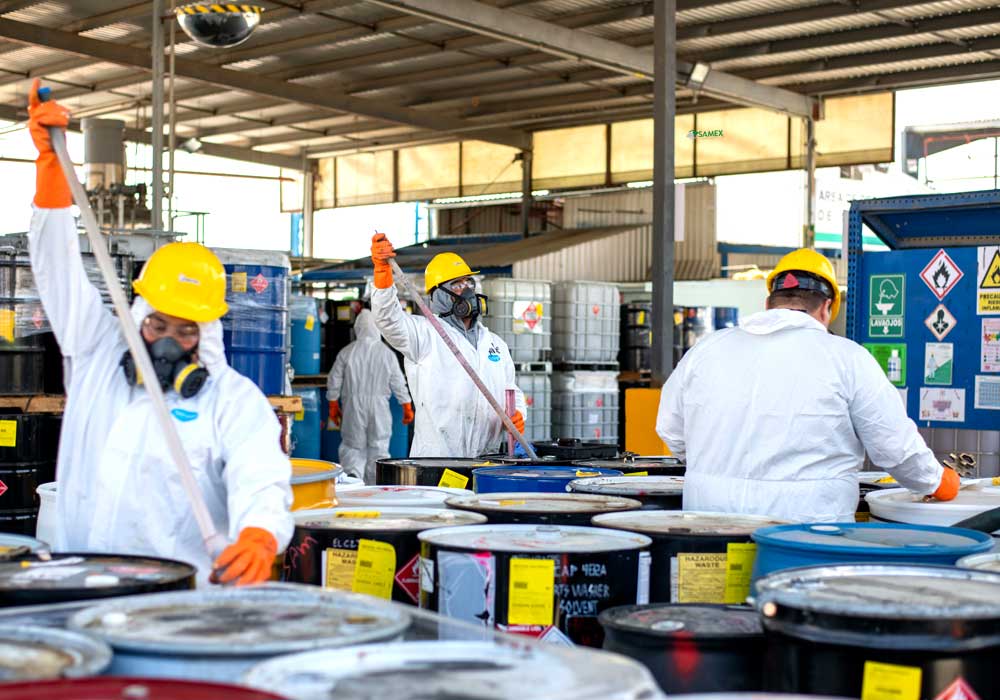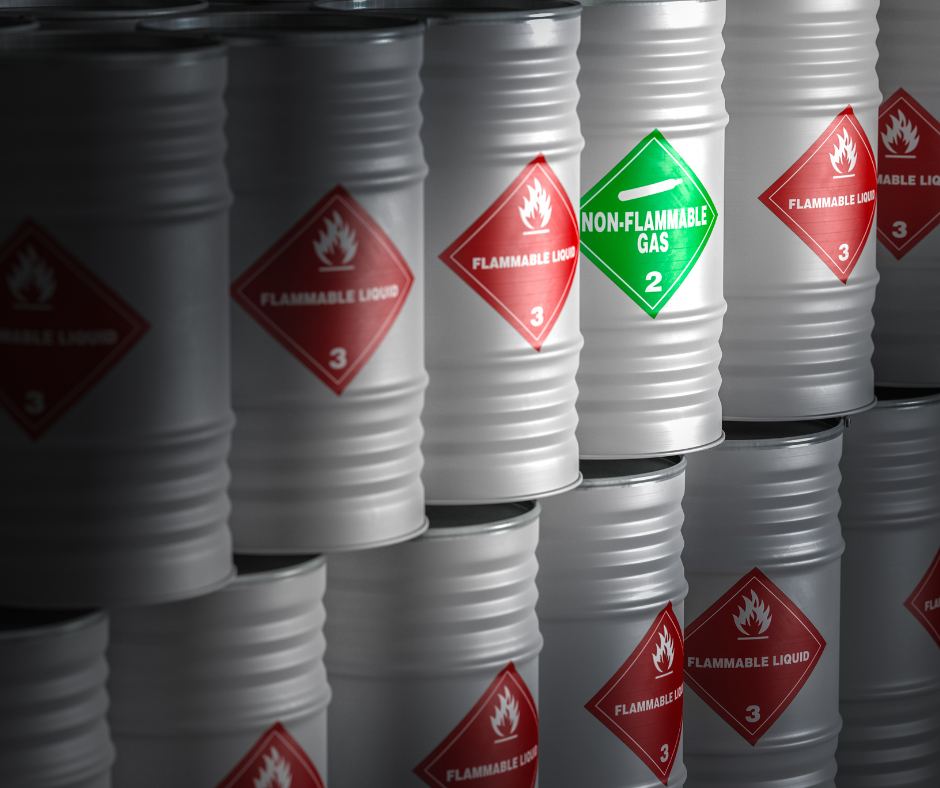Does Your Factory Meet These Storage of Flammable Liquids Regulations?
When handling flammable liquids in a factory setting, proper storage is not just a matter of convenience. It’s a critical safety measure that helps...
.png)
Class 1 flammable liquids are extensively used in various industrial applications, yet their usage carries inherent dangers that require special consideration.
What is a Class 1 flammable liquid? The National Fire Protection Association (NFPA) classifies flammable and combustible liquids into six classes: I-A, I-B, I-C, II, III-A and III-B. Flammable liquids are substances that can easily ignite and burn rapidly at normal temperatures. They have a low flash point, which is the lowest temperature at which a liquid can produce enough vapor to form an ignitable mixture in the air.
Class IA flammable liquids have a flash point below 73°F (23°C) and a boiling point below 100°F (38°C).
Class IB flammable liquids have a flash point below 73°F (23°C) and a boiling point at or above 100°F (38°C).
Class IC flammable liquids have a flash point between 73-100°F (24-38°C). There is no specific boiling point requirement with this classification.
A boiling point is the temperature at which a substance changes from a liquid to a gas at atmospheric pressure, while a flash point is the lowest temperature at which a liquid can produce enough vapor to form an ignitable mixture in the air.
Why is the information above important to know if you operate in a facility where Class 1 flammable liquids are present? Understanding how to store these substances, in which environments you should not use them and ultimately, how to dispose of them is crucial for maintaining a safe workplace environment, preventing accidents and complying with regulations.
Let’s dive into some examples of Class 1 flammable liquids you may have onsite at your facility and what you need to know about using and disposing of them in your industrial processes.
Some examples of Class 1 flammable liquids you may use as part of your industrial processes include:.png?width=300&height=251&name=Hazardous%20Waste%20Disposal-Bebas%20Neue%20(1).png)
Class 1A Flammable Liquids
Notes:
Ligroin and Petroleum Ether are mixtures, not pure compounds — their classification depends on the specific boiling range and composition.
If Petroleum Ether's boiling point is below 100°F, it may be Class 1A, but some formulations are Class 1B.
Class 1B Flammable Liquids
Class IC Flammable Liquids
Class 1 flammable liquids can pose significant fire hazards if not handled and stored properly. Here are some general guidelines for storing Class 1 flammable liquids:
By following these guidelines, you can help minimize the risks associated with storing Class 1 flammable liquids and promote a safe working environment. However, there are some environments or scenarios in which your employees should avoid using Class 1 flammable liquids.
There are certain environments where the use of Class 1 flammable liquids should be avoided altogether due to the.png?width=300&height=251&name=Hazardous%20Waste%20Disposal-Bebas%20Neue%20(2).png) heightened risk of fire and explosion. Some examples include:
heightened risk of fire and explosion. Some examples include:
In general, it's important to assess the specific risks and hazards of each environment before using or storing flammable liquids and to implement appropriate safety measures to mitigate these risks effectively. If unsure, consult with safety professionals or regulatory authorities who can provide guidance on safe practices and compliance with relevant regulations.
Disposing of Class 1 flammable liquids is a highly regulated process and requires specialized transportation to hazardous waste disposal facilities. Dumping flammable liquids indiscriminately can pose serious environmental and safety hazards due to the risk of fires, contamination of soil and water sources, and harm to wildlife and ecosystems.
Hazardous waste disposal companies specialize in handling and disposing of materials like flammable liquids. Before disposal, the flammable liquid must be securely packaged in containers suitable for transporting hazardous materials. These containers should be properly labeled with the contents and hazard warnings to ensure safe handling during transportation.
Once packaged, the hazardous waste disposal company will arrange for the transportation of the flammable liquid to their designated disposal facility. They will handle all aspects of transportation in accordance with regulations and guidelines for transporting hazardous materials.
Among the facilities that can handle this type of hazardous waste, solvent distillation facilities offer businesses an opportunity to meet their sustainability objectives while safely disposing of flammable spent solvents.
What is solvent distillation? This process takes a liquid or vapor mixture of two or more substances and separates it into its component fractions of desired purity. Through the application of heat, this process separates the solvents from other substances. By heating a liquid mixture containing solvents, the solvent then vaporizes. The vapor is condensed back into a liquid form, resulting in the separation and recovery of the solvent.
Solvent distillation can be a sustainable option when looking for disposal solutions for your flammable liquids. However, some solvent distillation facilities can help you maximize the level of sustainability you are able to achieve when managing your waste.
For example, at Samex, we focus on ensuring nothing is wasted. During the solvent distillation process at our facility, any still bottoms that are generated are transferred to our fuel blending area. Here, they are blended with other flammable liquids, which meets the specifications of the cement kiln that will use the blend as an alternative fuel source.
Samex also has a water treatment plant on site where commercially clean, nonhazardous water is repurposed for brick manufacturing. Solid byproducts from the treatment process are sent to the fuel blending area, where they become part of the repurposed waste destined for the cement kiln to be used as an alternative fuel.
While managing any waste generated by using Class 1 flammable liquids during your manufacturing processes can be challenging, there are options available to you that ensure the safe disposal of this waste and help you meet your sustainability objectives. A solvent distillation plant that prioritizes a circular economy where nothing is wasted can help you meet these objectives while fostering a more resilient manufacturing operation.
.png)
When handling flammable liquids in a factory setting, proper storage is not just a matter of convenience. It’s a critical safety measure that helps...

Industries rely on a variety of flammable liquids for critical processes. However, the disposal of these hazardous substances poses environmental...

Fire safety is a critical aspect of industrial and everyday life, and it involves classifying materials based on their flammability and...